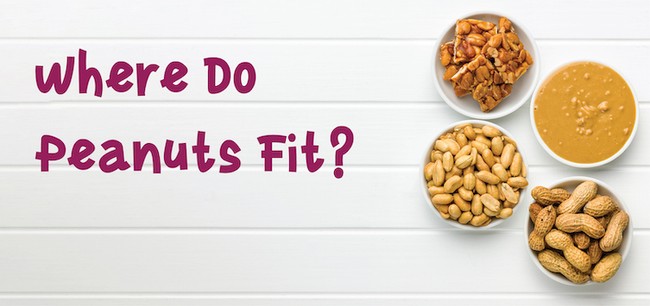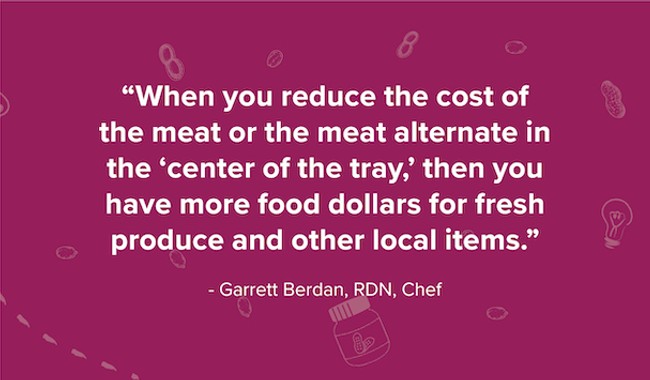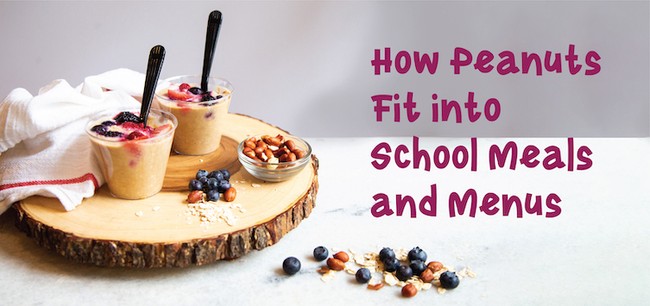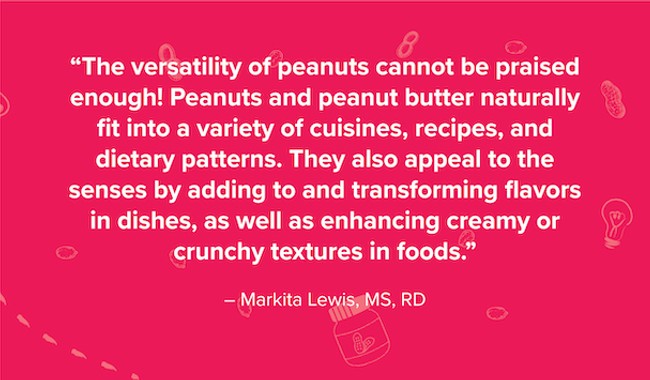Looking for new ways to power up your school meals with peanuts or peanut butter? Learn more from National Peanut Board’s free Peanut Power for Schools: Guide for Serving Peanuts in School Foodservice. In addition to five unique recipes that were thoughtfully developed and properly scaled for school foodservice, this guide includes nutrition information, resources for handling allergies, and guidance for conducting taste tests in schools.
Download the free toolkit here (PDF) or view the online version below.

Dear School Nutrition Professional,
Peanuts are a delicious and versatile food that provide a variety of vitamins and minerals in every bite, giving students the nutrients they need to live vibrant lives. The National Peanut Board created this guide to help incorporate peanuts into your school’s meals. Inside, we provide you with nutrition information and food group equivalents, inspiring recipes, and additional guidance on testing recipes and handling food allergies.
We hope you find this booklet helpful for your menu planning and foodservice operations. If you have additional questions about this content or how to best incorporate peanuts into your school menus, please email our team. We're happy to help.
Thank you for the tireless work that you do to keep our country's children healthy and well fed!
Sincerely,
National Peanut Board

Protein
Peanuts provide 7 grams of protein per 1-ounce serving.
Fiber
Peanuts are a good source of fiber, with one serving providing 10% of the recommended daily intake.
Fats
Peanuts provide mostly good fats that can help support heart health and brain development.
Scientific evidence suggests but does not prove that eating 1.5 ounces per day of most nuts such as peanuts as part of a diet low in saturated fat and cholesterol may reduce the risk of heart disease.
Vitamins and Minerals
Peanuts contain more than 30 essential vitamins and nutrients that are necessary to support growing kids.
- Vitamin E is a dietary antioxidant that helps to protect cells from oxidative stress, a normal, yet damaging, physiological process.
- Magnesium is important for muscle function including the heart, enzyme function, and energy production.
- Folate is needed for cell division, which means that adequate folate intake is especially important during childhood when tissues are growing rapidly.
- Copper is essential for red blood cell formation and for healthy blood vessels, nerves, immune system and bones.
- Phosphorus is important for the formation of teeth and bones, cell growth and muscle function, as well as helping the body use vitamins to create energy for cells.
Source: National Institutes of Health


School Nutrition Requirements
- 2 tablespoons of peanut butter can be counted as 1 meat/meat alternate option.
- 1 ounce of peanuts can be counted as 1 meat/meat alternate option.
Affordability
Peanut products provide a cost-effective, plant-based protein meat/meat alternate option with minimal labor investment that children love. Peanuts are versatile and can be used in a variety of recipes, ranging from snacks to meals. Using peanuts or peanut butter can also help reduce the cost of a full serving of another meat/meat alternate.
Convenience
Because it is shelf-stable, peanut butter is also a food that’s perfect for keeping in stock all the time as part of your emergency preparedness planning and in cases of supply chain disruptions.
Versatility
Peanuts and peanut butter can be used to meet the discriminating tastes of your students, harnessing food trends and preferences including global flavors, familiar favorites, and plant-based eating.
As schools look for ways to shift toward revised meal standards, peanut butter can brings lots of flavor and help reduce sodium and added sugar.


While there are no meat/meat alternate requirements for school breakfasts, peanuts or peanut butter can add important nutrition to students’ morning meals.


Savory Chicken Shawarma Bowl with Peanut Hummus
West African Peanut Stew
Rockin Rice Bowl with Peanut Butter Sauce & Chickpeas
Peanut Butter Granola Bars
Peanut Butter Overnight Oats


Try a new peanut recipe with your students to see for yourself just how much they love it. Here are a few tips and tricks for successful recipe taste-testing.
1. Get school staff and parents onboard
Before planning, be sure that you’ve obtained the necessary approvals from relevant school staff to conduct a taste test. Further, be sure parents are aware and have provided permission for their child to participate.
2. Ensure early and ongoing communication
Before the event, be sure to share the recipe, its nutritional values, and its ingredient information (highlighting any allergens) with students, parents, and school staff. At the start of the event, restate the recipe and ingredients and be sure that children with food allergies are not served their food allergen.
3. Select an ideal location for the event
Find a spot that meets your event needs and is convenient for students to access. Consider reserving an empty classroom or the cafeteria when it’s not in use so that tables are available for any discussion, focus groups, or surveys. If you conduct your taste test during meal service, consider the best way to collect feedback to avoid disruption to regular meal service procedures.
Have all your supplies nearby: Be sure you have small plates or cups for serving, napkins, and necessary utensils. You may also wish to include a trash bin nearby for convenience.
4. Serve safely
Have a plan in place to ensure that all food safety protocols are followed by anyone serving samples.
5. Share the ingredients
Be sure to have signage at your table that clearly identifies the ingredients and allergens in the recipe for any students who may avoid certain foods.
6. Plan for feedback
Use a voting or ballot system, worksheets, or other forms of surveying to collect feedback from students. These can include a mix of quantitative data (scores, counts, etc.) or qualitative feedback (open-ended questions, focus groups, etc.).

Approximately 98% of Americans can enjoy peanuts without any reaction, and about 2% of school aged children in the U.S. may have peanut allergy, according to the National Academies of Science, Engineering and Medicine. A combination of caution and preparation, along with a comprehensive food allergy management plan—including education of students and parents and training for all staff — helps reduce the risk of accidental ingestion and ensure that staff are ready in case a reaction occurs. Important allergen safe steps to consider include:
- Provide clear and adequate signage and labeling of common allergens on menus and serving lines.
- Clearly identify and label all containers involved in food preparation, serving, and storage.
- Use separate tools and equipment for preparation and service of allergen containing foods.
- Offer options on the menu each day.
- Conduct annual food allergy training to include cross-contamination, handwashing and cleaning, and how to respond to food allergy reactions.
Proper training is an important part of managing allergies in school foodservice. For more information, click the links to the videos shown below and visit peanutsinschools.org:

Download the free toolkit here (PDF)
